Wednesday, April 27, 2011
Nature's way
I just witnessed my first,Hawk kill.It was one of my Doves here in my yard.I capture these guys in pictures. Sad but I understand the cycle.
Thursday, April 7, 2011
BAD Hair day
LIZARD-HEAD
We humans often fret when--having showered and shampooed--we stare into the bathroom mirror and try to determine just what we've done to deserve a "bad hair day." A cowlick here, crooked bangs there, sometimes our crowning glory doesn't want to follow the lead of the brush and blow dryer, so off we go to work or on a date feeling a little out of sorts and slightly less confident because of a few misplaced hairs. Imagine what would happen to our psyches if we had to contend with the utter ignominy of being a "lizard-head" at Hilton Pond Center.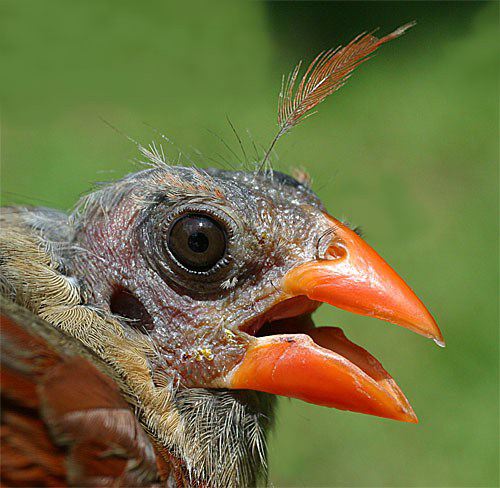
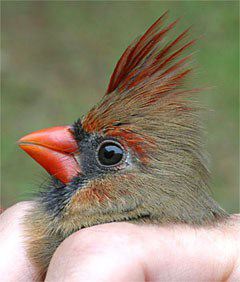 She has lost all but one of the feathers in what should normally be an elegant crest (below right), and she now looks for all the world like some kind of naked lizard-head mounted on the red-feathered body of a bird.
She has lost all but one of the feathers in what should normally be an elegant crest (below right), and she now looks for all the world like some kind of naked lizard-head mounted on the red-feathered body of a bird.If anyone has any doubt that birds and dinosaurs sprang from a common ancestor, even a cursory look at the top photo should convince them otherwise. The cardinal's ear opening and lack of an ear flap are just like that of a lizard, and the only real external differences between their heads is that lizards such as male Carolina Anoles (below left) have scales and toothy, bony jaws while birds have unscaled skin and toothless, horny bills. (NOTE: Having just experienced the pain that comes from a Northern Cardinal repeatedly clamping down on our finger while we took these photos, we might rather be bitten by a lizard with teeth.)
All birds go through molt, and most species replace all their feathers at least twice a year. In some birds winter plumage is very different from breeding attire, while other birds look pretty much the same year-round. Here in the Carolina Piedmont, Northern Cardinals normally replace their worn and dingy body feathers--including those on their heads--starting in mid-summer after breeding is done.
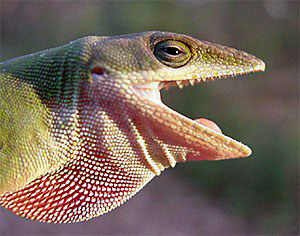 Typically they lose and bring in new feathers a few at a time, lest they end up being naked and completely unprotected from the elements. Thus, it's not unusual to see a male or female cardinal looking a bit ratty this time of year, missing a few plumes in its crown here, a tail feather or two there. What IS unusual is to find a bird with its entire tail gone or--worse yet--a head absolutely devoid of plumage. We get several e-mails or phone calls each year about this phenomenon, and folks always seem relieved to learn that instead of having some sort of alien mutant glow-in-the-dark lizard-bird at their feeders, it may be that they have a cardinal or Blue Jay or Eastern Towhee with a bad case of head mites. If a bird is infested with these little critters, it wouldn't be surprising for it to scratch continuously until many or all feathers within reach of the claws were worn off.
Typically they lose and bring in new feathers a few at a time, lest they end up being naked and completely unprotected from the elements. Thus, it's not unusual to see a male or female cardinal looking a bit ratty this time of year, missing a few plumes in its crown here, a tail feather or two there. What IS unusual is to find a bird with its entire tail gone or--worse yet--a head absolutely devoid of plumage. We get several e-mails or phone calls each year about this phenomenon, and folks always seem relieved to learn that instead of having some sort of alien mutant glow-in-the-dark lizard-bird at their feeders, it may be that they have a cardinal or Blue Jay or Eastern Towhee with a bad case of head mites. If a bird is infested with these little critters, it wouldn't be surprising for it to scratch continuously until many or all feathers within reach of the claws were worn off.This week's discussion of bald cardinals and head mites may have you subconsciously scratching your own scalp by the time you get to the end of this essay, but you probably don't have to worry about getting mites from birds--unless you have a bunch of House Sparrows, Rock Doves, or some native colonial bird species nesting in the attic above your bed. Birds actually host a great many kinds of mites, but most of these little parasites aren't interested in sucking human blood; they may inflict test bites on people, but they seldom hang on for a real meal. When they do, however, they can cause serious discomfort and are even suspected of being vectors of debilitating disease.
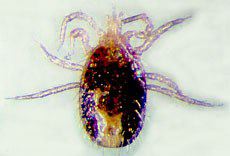 Mites resemble ticks in structure but are far smaller; many are tiny enough to fit on the head of a pin with room to spare, and some must be viewed with at least a low-power microscope to be seen at all. Their larvae usually have three pairs of legs; as nymphs, most gain a fourth pair that is retained in the adult stage (right). Mouth parts on typical mites are adapted for piercing the integument of their hosts; species that live on people can cause intense itching that apparently results from allergic reaction to the mites' metabolic waste products. Scab Mites (which cause "scabies") and Mange Mites are among the most common parasites of domesticated animals and their owners, while House Dust Mites live in our bed sheets, dining on the unending supply of dead skin cells shed from our bodies.
Mites resemble ticks in structure but are far smaller; many are tiny enough to fit on the head of a pin with room to spare, and some must be viewed with at least a low-power microscope to be seen at all. Their larvae usually have three pairs of legs; as nymphs, most gain a fourth pair that is retained in the adult stage (right). Mouth parts on typical mites are adapted for piercing the integument of their hosts; species that live on people can cause intense itching that apparently results from allergic reaction to the mites' metabolic waste products. Scab Mites (which cause "scabies") and Mange Mites are among the most common parasites of domesticated animals and their owners, while House Dust Mites live in our bed sheets, dining on the unending supply of dead skin cells shed from our bodies.Although taxonomy of mites is under debate, many authorities place them in the Acari, a large arthropod order that includes Ticks. Mites are arranged differently by various taxonomists but usually include several discrete families, including the Harvest Mites or Chiggers (Trombiculidae), Itch Mites (Sarcoptidae), and Follicle Mites (Demodicidae, miniscule organisms that live in lashes and sebaceous glands of the human eye); all these parasitize people--or at least scavenge thereupon--but Bird Mites (Dermanyssidae) pretty much stick to avian hosts. Water Mites (Hydrachnidae) have fringed legs adapted for swimming and inhabit freshwater rivers and lakes where they prey upon macroinvertebrates, while four-legged Spider Mites (Tetranychidae) spin miniature webs on the undersides of leaves, where they suck sap and sometimes cause galls or kill host plants. Hummingbirds are even known to transport plant mites from flower to flower as they sip nectar and help cross-pollinate.
Bird Mites are usually thought of as skin parasites; some species are more specialized and inhabit esoteric locales such as a bird's air sacs or crevices between the scales on its legs.
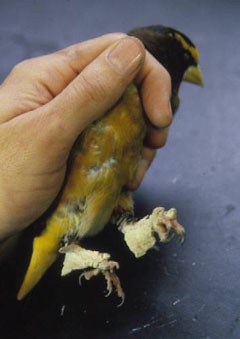 Occasionally at Hilton Pond Center we capture a bird with a case of "scaly-leg" so bad that we have to forego banding the bird. The absolute worst infestation of leg mites we've encountered was on a male Evening Grosbeak in Minnesota; pinkish-yellow wing-like crustiness covered the entire length of both legs (left). This condition almost certainly affected the grosbeak's behavior, and--as with other kinds of arthropod parasites--Scaly-leg Mites may have had potential to eventually kill the host.
Occasionally at Hilton Pond Center we capture a bird with a case of "scaly-leg" so bad that we have to forego banding the bird. The absolute worst infestation of leg mites we've encountered was on a male Evening Grosbeak in Minnesota; pinkish-yellow wing-like crustiness covered the entire length of both legs (left). This condition almost certainly affected the grosbeak's behavior, and--as with other kinds of arthropod parasites--Scaly-leg Mites may have had potential to eventually kill the host.It's not clear to us whether shiny-pate Northern Cardinals can die directly because of baldness, but complete loss of head feathers seems likely to cause stress in a bird. A bald-headed cardinal won't fare very well on a cold, rainy day, and all that bare skin is exposed to mosquito bites that these days could lead to West Nile Virus. Perhaps more important, researchers have found that potential mates don't respond favorably to birds with aberrant plumage; thus, a naked head instead of a feathery crest might mean a mite-laden bird wouldn't get a chance to breed and pass on its genes. In the case of this week's lizard-headed Northern Cardinal female, a well-developed incubation patch indicates she is or has been sitting on either eggs or nestlings, but she probably won her suitor's eye well before losing all her head plumage. If she's carrying mites, there's now a good chance she'll share her parasite collection with her offspring.
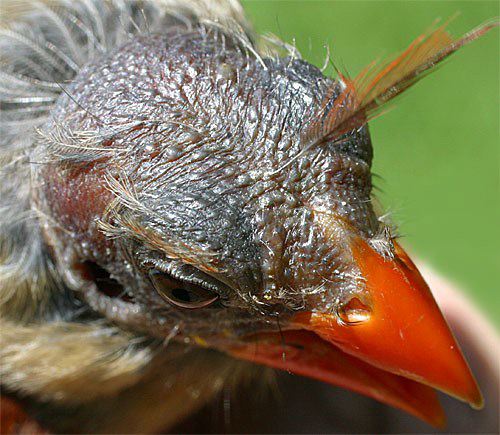 All text & photos © Hilton Pond Center
All text & photos © Hilton Pond Center All text & photos © Hilton Pond Center
CAVEAT #1: It's worth noting that some authorities believe the simultaneous loss of head feathers in wild birds may be due to factors other than or in addition to mites and the scratching behavior that results from infestation. Factors might include nutritional deficiencies, high temperature, or other environmental stress; it's even possible total feather loss may be a normal occurrence for individual birds. We also caught a male Northern Cardinal this week that was half-bald and infested with feather lice, so there actually may be other parasites that cause or add to the baldness. One other interesting note is that some bird mites only inhabit the host for short periods of blood-sucking before hiding in the nest for the remainder of the day; thus, a bird affected by mites might not actually be carrying them when it is captured during the banding process and would show no direct evidence of being infested by the parasite. The whole phenomenon is worthy of further study.
POSTSCRIPT #1: Dr. Jim Philips (Babson College), who studies mites, responded to our info above by saying "I would not expect your mites to be dermanyssids--they suck blood but don't directly cause feather loss. Burrowing skin mites--Harpyrhynchidae or Knemidocoptidae or Epidermoptidae--cause feather loss directly, in a fashion similar to the way mange mites cause fur loss in mammals." Some banders have wondered why mites that cause baldness in birds can't be seen when the bird is in-the-hand; Dr. Philips' explanation suggests that the mites could be embedded in the skin and would not be easily detected. However, he also cautioned that follicle mites have NOT been collected and identified from bald birds.
POSTSCRIPT #2: On 2 May 2004 we retrapped a male Northern Cardinal (#8101-40966) that had been banded at Hilton Pond Center as a recent fledgling on 8 July 2002. At recapture, this bird exhibited baldness very similar to that depicted in the female cardinal in the photos above. Cardinals do not typically undergo head molt this early in the season; in fact, most bald cardinals show up in mid-summer when some have suggested that loss of head feathers could be part of the normal molt process. A bald cardinal in early May seems to undermine that supposition and implies some other factor(s) might be involved. (NOTE: This individual was also recaptured locally on 09/18/02, 12/12/02, 06/02/03, and 07/07/03; it had normal head feathering on all those dates.)
POSTSCRIPT #3: Northern Cardinal #8101-40837, the female in the photos above, was recaptured on 10/27/03 with no sign of baldness.
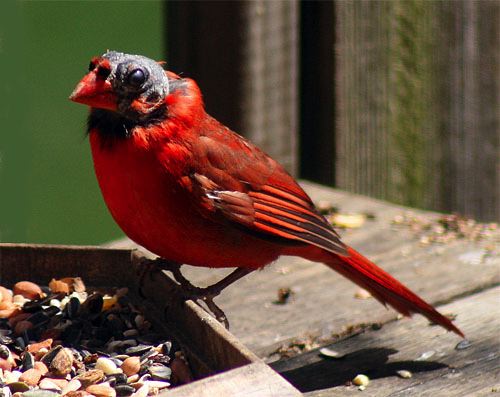
All text & photos © Hilton Pond Center
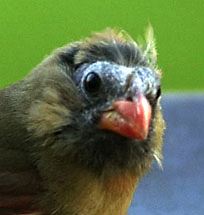 In this photo the bird's nictitating membrane (transparent "third eyelid") completely covers the eye, making it look somewhat gray; the membrane is retracted in other photos from Debbie.
In this photo the bird's nictitating membrane (transparent "third eyelid") completely covers the eye, making it look somewhat gray; the membrane is retracted in other photos from Debbie.On 20 April 2007 we received another photo (left)--this time of a female cardinal coming to a feeder at the home of Cathy and Tracey Trumbull, who live within a mile of the Schweinbergs. This bird showed partial baldness that likely is caused by mites rather than a "normal" molt. TheTrumbulls also reported a bald male cardinal that could be the same bird photographed by Debbie Schweinberg.
Credits to Hilton Pond Center
Subscribe to:
Comments (Atom)